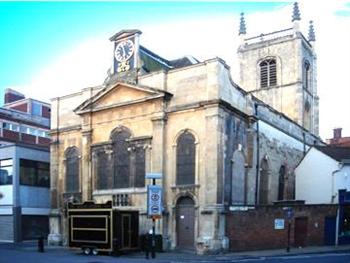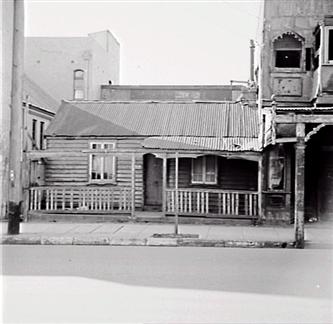|
i.
|
|
George Sparks, born
9/8/1805 & baptised 25/8/1805, Colwall, Co Hereford,
England.[397,406,409,410,411] Died 1/5/1869, Lehi, Utah Co, Utah,
USA.[397,406,409,410,411] Married Hannah Leek, 19/4/1831, Saint Michael
Bedwardine, Worcester, Co Worcester, England.[395,397,409,410,411]
Hannah, d/o Andrew & Eleanor,[409,411] born 24/5/1807, Castle
Morton, Co Worcester,[388,390,397,409,410,411] baptised 29/5/1809,
Castlemorton, Co Worcester, England,[397,406] & died 1/6/1857,
Philadelphia, Pensylvania, USA.[395,397,406,409,411] Married Jane
Mears.[406,410] Married Fullerton Stewart.[406,410] Resided 1841, Holt,
Martley district, Co Worcester, England.[388] Resided 1851, Ombersley
& Hartlebury, Droitwich district, Co Worcester, England.[390] In
1853 George & his family emigrated to the USA, settling in Salt
Lake City, Utah, USA, converting to the Mormon religion.[406]) Resided
1860, Lehi, Utah Co, Utah, USA.[409]
Children:
(a)
|
|
Charles
Sparkes, born 1832, Co Worcester, England.[388] Died December quarter,
1849, Martley district, Co Worcester, England,[387] & buried
7/10/1849, St Bartholomew, Grimley, Co Worcester, England (17yo).[401]
With parents, 1841.[388] |
| (b) |
|
Mary Ann Sparks, born
10/12/1833 & baptised 15/12/1833, Grimley, Co Worcester,
England.[395,397,406,409,410,411] Died 2/7/1905, Dingle, Bear Lake Co,
Idaho, USA.[395,397,406,409,410,411] Buried Brigham
City Cemetery, Box Elder, Utah, USA.[411] With parents,
1841,1851.[388,390] Married George Davis, 27/12/1853, Claines, Co
Worcester, England.[387,395,409,410,411] George born 8/12/1833,
Norchard, Hartlebury, Co Worcester, England & died 14/6/1903,
Perry, Box Elder Co, Utah, USA.[409,411]
Children:
(1)
|
|
Margaret Caroline Davis, born 1/7/1854, Kansas
City, Missouri, USA.[411] Died c.10/7/1854, Missouri, USA.[411] |
| (2) |
|
George James Davis, born 25/11/1855, Salt Lake
City, Salt Lake Co, Utah, USA.[411] Died 14/11/1928, Bell, Los Angeles,
California, USA.[411] |
| (3) | | Hannah Elizabeth Davies, born 15/11/1857, Salt Lake City, Salt Lake Co,
Utah, USA.[411] Died 3/12/1903, Clarkson Co, Utah, USA.[411] | | (4) | | Alfred William Davis, born 3/10/1859, Lehi, Utah
Co, Utah, USA.[411] Died 11/10/1859, Lehi, Utah Co, Utah, USA.[411] | | (5) | | male Davis, born 3/10/1859, Lehi, Utah Co, Utah,
USA.[411] Died 3/10/1859, Lehi, Utah Co, Utah, USA.[411] | | (6) | | Nelson Franklin Davis, born 15/10/1860, Lehi,
Utah Co, Utah, USA.[411] Died 6/2/1931, Ogden Co, Utah, USA.[411] | | (7) | | Orson Charles Davis, born 15/3/1863, Lehi, Utah
Co, Utah, USA.[411] Died 10/2/1865, Lehi, Utah Co, Utah, USA.[411] | | (8) | | Vinson Frederick Davis, born 8/2/1865, Lehi, Utah
Co, Utah, USA.[411] Died 2/8/1928, Bear River Duck Club, Box Elder Co,
Utah, USA.[411] | | (9) | | Mary Laura Davis, born 1/2/1867, Lehi, Utah Co, Utah, USA.[411] Died 12/6/1885.[411] | | (10) | | Olivia Fullerton Rebecca Davis, born 6/5/1872,
Clarkson, Cache Co, Utah, USA.[411] Died 13/6/1938, Perry, Box Elder
Co, Utah, USA.[411] | | (11) | | Benjamin Ephraim Davis, born 15/5/1872, Clarkson, Cache Co, Utah,
USA.[411] Died 1/8/1875, Utah, USA.[411] | | (12) | | Arthur Nephi Davis, born 10/9/1876, Three Mile
Cross, Utah, USA.[411] Died 17/10/1894.[411] |
|
| (c) | | Alfred Sparks, born 7/3/1835, baptised 14/3/1835, St Philip & St
James, Hallow, Co Worcester, England.[395,397,406,409,410,411] Died
15/8/1914, Dingle, Bear Lake Co, Idaho, USA.[397,406,409,410,411] With
parents, 1841,1851.[388,390,409] Married Jane Ann Fowler,[411]
30/1/1853, at sea on the 'Ellen Maria'.[406,409,410] Jane born
27/11/1835, Baughton, Co Worcester, England.[409,410] Married Ruth
Slater, 21/3/1863, Salt Lake City, Utah, USA.[395,406] Ruth, d/o James
& Hannah, baptised 4/1/1838, Clifton, Co Bedfordshire,
England,[395] died 31/7/1901, Dingle, Bear Lake Co, Idaho, USA &
buried 2/8/1901, Dingle, Bear Lake Co, Idaho, USA.[410] Resided 1880,
Dingle Dell, Bear Lake Co, Idaho, USA.[409]
Children:
(1)
|
|
Hannah Elizabeth Sparks, born 28/3/1864, Lehi,
Utah Co, Utah, USA.[410] Died 12/2/1909, Moreland, Bighorn Co, Idaho,
USA.[410] Married William Thomas Lindsay, 22/9/1881, Salt Lake City,
Salt Lake Co, Utah, USA.[410] |
| (2) |
|
James Alexander Sparks, born 21/9/1865, Lehi, Utah Co, Utah,
USA.[410] Died 10/7/1922, Dingle, Bear Lake Co, Idaho, USA & buried
15/7/1922, Dingle, Bear Lake Co, Idaho, USA.[410] Married Rosina
Margaret Nate, 3/10/1888, Logan, Cache Co, Utah, USA.[410] Rosina, d/o
Samson & Mary Ann, born 19/6/1870, Paris, Bear Lake Co, Idaho, USA,
died 29/8/1922, Montpelier, Bear Lake Co, Idaho, USA & buried
3/9/1922, Dingle, Bear Lake Co, Idaho, USA.[410] |
| (3) | | Frances Mary Sparks, born 10/5/1868, Paris, Bear
Lake Co, Idaho, USA.[410] Died 3/2/1943, Dingle, Bear Lake Co, Idaho,
USA.[410] Married Franklin Eaton Smedley, 1/10/1885, Dingle, Bear Lake
Co, Idaho, USA.[410] | | (4) | | Joseph
Sparks, born 10/5/1869, Paris, Bear Lake Co, Idaho,
USA.[410] Died 10/5/1869.[410] | | (5) | | Frederick William, born 13/8/1870, Paris, Bear
Lake Co, Idaho, USA.[410] Died 1/10/1872, Paris, Bear Lake Co, Idaho,
USA.[410] | | (6) | | Henry Edward
Sparks, born 11/6/1872, Paris, Bear Lake Co, Idaho, USA.[410] Died
29/5/1888, Bear Lake Co, Idaho, USA.[410] |
| | (d) | | Caroline Sparks, born September quarter, 1837, Hallow, Martley
district,[387] and baptised 7/8/1837, St Philip & St James, Hallow,
Co Worcester, England.[395,397,406,409,410,411] Died December quarter,
1838, Martley district,[387] & buried 15/10/1838, St Philip &
St James, Hallow, Co Worcester, England (14mo).[395,397,401,410,411] | | (e) | | George Sparks, born 22/2/1840, Hallow, Martley
district,[387,395,397,406,409,410,411] baptised 22/3/1840, St Philip
& St James, Hallow, Co Worcester, England.[395,397,406,410] Died
18/4/1871, Clarkston, Cache Co, Utah, USA.[395,397,406,409,410,411]
With parents, 1841,1851.[388,390] Married Hannah Davis, 14/2/1859, Iowa
City, Johnson Co, Iowa, USA.[395,406,410] Hannah, d/o William &
Mary, baptised 26/3/1841, Garnoach, Co Monmouth, Wales, died 11/2/1918,
Carey, Blaine Co, Idaho, USA.[395,409] Resided 1859, Idaho, USA.[409]
Resided 1859,1860, Lehi, Utah Co, Utah, USA.[409] Resided 1863,1870,
Clarkson, Cache Co, Utah, USA.[409]
Children:
(1)
|
|
George Henry Sparks, born 14/12/1859, Lehi, Utah
Co, Utah, USA.[409] Died 14/12/1859, Lehi, Utah Co, Utah, USA.[409] |
| (2) |
|
Alfred William Sparks, born 2/1/1861, Clarkson,
Cache Co, Utah, USA.[409] Died 15/3/1931, Nampa, Canyon Co, Idaho,
USA.[409] Married Martha Ann Godfrey.[409] Martha born 22/10/1866, Salt
Lake City, Utah, USA & died 25/3/1941, Nampa, Canyon Co, Idaho,
USA.[409] |
| (3) | | Mary Jane Sparks,
born 16/4/1863, Clarkson, Cache Co, Utah, USA.[409] Died 8/12/1869,
Clarkson, Cache Co, Utah, USA.[409] | | (4) | | John Albert Sparks, born 11/5/1865, Clarkson,
Cache Co, Utah, USA.[409] Died 25/5/1925, Montana, USA.[409] Married
Annie Esterholdt, 26/2/1890, Dingle, Bear Lake Co, Idaho, USA.[409]
Annie born 22/6/1871, Copenhagen, Denmark & died 30/4/1937,
Montpelier, Bear Lake Co, Idaho, USA.[409] | | (5) | | Hyrum Morgan Waters Sparks, born 12/3/1867,
Clarkson, Cache Co, Utah, USA.[409] Died 1/11/1944, Carey, Blaine Co,
Idaho, USA.[409] Married Charlotte Goddard, 24/1/1887, Samaria, Oneida
Co, Idaho, USA.[409] Charlotte, d/o Eli & Amelia, born 12/6/1869,
Malad, Oneida Co, Ohio, USA & died 14/5/1935, Carey, Blaine Co,
Idaho, USA.[409] | | (6) | | George
Wilfred Sparks, born 29/7/1869, Clarkson, Cache Co, Utah, USA.[409]
Died 30/7/1954, Carey, Blaine Co, Idaho, USA.[409] Married Harriett
Esterholdt, 20/10/1890, Dingle, Bear Lake Co, Idaho, USA.[409] Harriett
born 17/2/1873, Copenhagen, Denmark, & died 16/7/1955, Hailey,
Blaine Co, Idaho, USA.[409] |
| | (f) | | William Sparks,
born 11/7/1846,[387,395,397,406,409,410] & baptised 12/8/1846,
St Andrew, Ombersley, Co Worcester, England.[395,397,406,410,411] Died 14/6/1930,
Smithfield, Cache Co, Utah, USA.[397,406,409,410,411] With parents,
1851.[390] Married Bethea Buttars, 15/12/1868, Salt Lake City, Salt
Lake Co, Utah, USA.[395,406,409,410] Bethea, d/o David & Margaret,
born 25/6/1851, Blairgowrie, Perthshire, Scotland, & died
12/2/1880, Clarkson, Cache Co, Utah, USA.[409,410] Married Elizabeth
Jane Clark,[395,406] 27/1/1882.[410] Married Clara Fanny White,[395]
16/9/1898, Logan, Cache Co, Utah, USA.[406,410] Clara born 28/2/1868,
Smithfield, Cache Co, Utah, USA, died 8/10/1954, Clarkson, Cache Co,
Utah, USA.[409] Resided 1870, Newtown, Cache Co, Utah, USA.[409]
Resided 1880,1900, Clarkson, Cache Co, Utah, USA.[409]
Children:
(1)
|
|
William Sparks, born 1870, Cache Co, Utah, USA.[411] |
| (2) |
|
Margaret Sparks, born 1873, Cache Co, Utah, USA.[411] |
| (3) | | David Sparks, born 1875, Cache Co, Utah, USA.[411] | | (4) | | George A. Sparks, born 1879, Cache Co, Utah, USA.[411] |
|
|










































































































